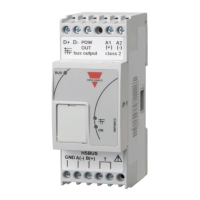What to do if the CARLO GAVAZZI Dupline display is blank?
- LLauren JohnsonAug 3, 2025
If the display of your CARLO GAVAZZI Industrial Equipment is blank, it could be due to several reasons. First, check if the RS485 is incorrectly connected or not connected, and if so, reverse the wires. Other potential causes include a power outage, incorrect settings for DIP switch D2 on the display, or the L2 bus not working correctly.

